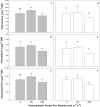Physiological responses and antioxidant properties of coriander plants (Coriandrum sativum L.) under different light intensities of red and blue lights
- PMID: 36477410
- PMCID: PMC9729621
- DOI: 10.1038/s41598-022-25749-3
Physiological responses and antioxidant properties of coriander plants (Coriandrum sativum L.) under different light intensities of red and blue lights
Abstract
Coriander (Coriandrum sativum L.) contains abundant antioxidants and essential oils which can provide antibacterial, antifungal, and antioxidant activities in the pharmaceutical, health and food production industry. To improve the economic values of coriander, the relationships between optimal light treatments for maximizing both plant growth and the antioxidant and essential oil content of coriander leaves need to be determined. Plants were exposed to five light-emitting diodes spectral color mixtures, high blue light (BL) intensity induced the levels of reducing power response. The light treatments were then adjusted for the analysis of secondary metabolite compounds of coriander leaves. Among 30 identified compounds, the amounts of decamethyl-cyclopentasiloxane and dodecane were significantly reduced in the R80 + G50 + B50 condition, whereas dodecamethyl-cyclohexasiloxane level was significantly reduced in R50 + G50 + B80 condition. Various light quality and intensity combinations influenced the accumulations of chlorophyll and phytochemical contents, mediated antioxidative properties, and secondary metabolites of coriander leaves, which may be useful in developing a new LED lighting apparatus optimized for coriander production in plant factories.
© 2022. The Author(s).
Conflict of interest statement
The authors declare no competing interests.
Figures





References
-
- Mandal S, Mandal M. Coriander (Coriandrum sativum L.) essential oil: Chemistry and biological activity. Asian Pac. J. Trop. Biomed. 2015;5:421–428. doi: 10.1016/j.apjtb.2015.04.001. - DOI
-
- Bogavac M, Karaman M, Janjušević L, Sudji J, Radovanović B, Novaković Z, Simeunović J, Božin B. Alternative treatment of vaginal infections—in vitro antimicrobial and toxic effects of Coriandrum sativum L. and Thymus vulgaris L. essential oils. J. Appl. Microbiol. 2015;119:697–710. doi: 10.1111/jam.12883. - DOI - PubMed
-
- Lin KH, Huang MY, Huang WD, Hsu MH, Yang ZW, Yang CM. The effects of red, blue, and white light-emitting diodes on the growth, development, and edible quality of hydroponically grown lettuce (Lactuca sativa L. var. capitata) Sci. Hortic. 2013;150:86–91. doi: 10.1016/j.scienta.2012.10.002. - DOI
Publication types
MeSH terms
Substances
LinkOut - more resources
Full Text Sources

